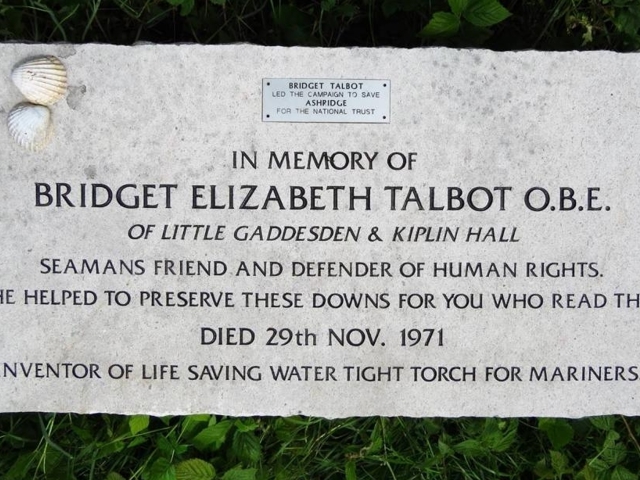Bridget Talbot
Bridget Talbot 1885 - 1971
Bridget Talbot was born and brought up in Little Gaddesden, the niece of Lord Brownlow. Throughout her life she had connections and links with Edlesborough. When she died her ashes were scattered, at her request, 'over the little stream off the grass road between Edlesborough and Ivinghoe, in view of the nine miles stretch of wood and country, and a stone put up. ..... To say that I saved them for the National Trust.' In due course this memorial bench was put up by her Trustees to mark the spot.
Created by Friends of the Church on the Hill for a Heritage Open Days Display at St. Mary's Church 2018 - Theme 'Significant Women'
1885 Bridget was born in January, the second of 4 children of Alfred and Emily Talbot. They lived at Little Gaddesden House, part of the Ashridge estate, which was owned by Earl Brownlow, husband of Alfred’s sister Adelaide.
1891 There was a particularly severe and long winter and Alfred and Emily, who were active in the area helping local people, organised a soup kitchen 3 times a week at Ivinghoe and Edlesborough, and gave sacks of coal to tenants. (About half of Edlesborough families were tenants of Ashridge). Bridget was 6 years old. Alfred sometimes took church services at Edlesborough as a layman.

Photo of Bridget as a child courtesy of Trustees of Kiplin Hall.
Bridget grew up in a large extended family where all the arts were appreciated. Her mother sketched and painted watercolours, her Talbot aunts, including Adelaide, patronised artists such as Edward Burne-Jones and GF Watts.
Throughout her life, when travelling, she painted vignettes of local scenery and people. In 1909 she visited the Musee de Luxembourg in Paris and bought many postcards of the sculptures of Auguste Rodin. Later that year and in 1910 she pasted photos of 7 of her own sculpted busts into a scrapbook.
1910 Bridget organised a concert to raise funds for a scout troop in Little Gaddesden, Lord Baden-Powell having written “Scouting for Boys” in 1909. The troop started in 1911 and Bridget became its President.
1914 World War 1 broke out when Bridget was 29 years old.
- summer - attended training courses in nursing.
- Organised the Little Gaddesden Cooperative scheme in her home village to ensure local food production. The Ministry of Agriculture later adopted her scheme.
- October – became a member of the Belgian Refugee Committee, when depots were opened at Alexandra Palace and Earls Court to house Belgian refugees.
1915 January – travelled through France to the Austrian-Italian war zone, where she served with the Anglo-Italian Red Cross on the mountainous battle front. British nurses received soldiers wounded in the trenches, fed and tended to their wounds than sent them by train to the base hospitals, so she was very close to the fighting. She wrote home regularly: here are 2 extracts:
- ‘Jan 22 1915 – It is a fearful job getting the wounded down from the trenches – they have to be dragged part of the way or brought on mules – and then by ambulances, and a great many die on the way.’
- ‘March 17 1916 – We had a thrilling evening a few nights ago watching the battle of Mte San Michele. Shells and shrapnel bursting and the Austrian searchlight bombs. From time to time the big guns stopped and then we knew they were charging. It is beastly being only a spectator and not being in the thick of it oneself.’
She remained with the Red Cross until 1919 and supported the organisation all her life. She was awarded the Italian medal for valour, the Croce di Guerra.
1920
- She was awarded an OBE for her war work.
- She went to Touzla camp near Constantinople, which housed 2000 Russian war refugees and later set up a co-operative farm colony for the refugees in Asia Minor.
The Ashridge Estate
Ashridge Estate was put up for sale when Earl Brownlow died childless in 1921. A letter appeared in the Times on 9 October 1925 from Constance Sitwell (Bridget’s cousin) warning of the possible sale of Ashridge to a syndicate for commercial purposes eg house building. The documents were to be signed in one month’s time.
Ashridge was Bridget’s childhood playground and she was determined that others should also enjoy the famous beech woods and rides that she had experienced. So she travelled immediately to London, where she went round gathering signatures for a letter to the Times to protest against the sale and to obtain support for its preservation by the National Trust.
In just a few hours she had signed up supporters including Stanley Baldwin, Ramsay MacDonald and Lord Oxford as well as Lord Gray of Falloden, her cousin, who had been at 10 Downing Street when she called there, where a Cabinet meeting was in progress.
10th October 1925 - The Times published their letter, urging people to send money to the National Trust with all speed, to purchase land between Ivinghoe Beacon and Berkhamsted Common.
‘We believe that there are few if any parks that combine so many features of desirability for public acquisition a Ashridge … it is amongst the most richly timbered of parks and has adjoining it stretches of downland, with magnificent views.’
Within a few weeks the money was raised and the estate was indeed purchased for the National Trust.
1939 World War 2 broke out when Bridget was 54 years old.
· She started the National Labour Enquiry into the state of the Merchant Navy and invented the waterproof torch for use on rafts and lifesaving equipment, see separate page, ‘Invention of the Waterproof Torch’.
She worked for the welfare of other troops too. Her relative, Barbara Cassell, later recalled a story from Bridget:
“I arrived at Glasgow Railway Station during the war to see thousands of soldiers settling down for the night on the hard platform. I asked what was going and was told that they were due to embark in a convoy to fight abroad but, owing to the possibility of air raids, had to stay on land until the last minute. I asked the officer why he didn’t find proper accommodation for them but he shrugged his shoulders.
So the next day I booked a room in the best hotel and told the Red Cross the Press was coming and told the Press that the Red Cross was coming. We had the meeting and they appointed me to go the Lord Provost of Glasgow. I told him he could accommodate lots of soldiers in his corridors alone. I said it was monstrous that these men were going abroad to fight for us and we were letting them spend their last nights in this country on hard platforms. He gave in and billets were arranged for the men.”

Bridget’s cousin Sarah had made Bridget the joint owner of Kiplin Hall, Yorkshire in 1938. As with Ashridge, Bridget hoped that The National Trust would take over Kiplin Hall but they finally rejected it, after many years’ campaigning, in 1958. So she set up the Kiplin Hall Trust and left the contents of the house to them when she died. However she continued to live at Little Gaddesden as well as at Kiplin Hall.
29 November 1971 - Bridget Talbot died at Kiplin Hall at the age of 86, and asked for her ashes to be scattered ‘over the little stream off the grass road between Edlesborough and Ivinghoe, in view of the nine miles stretch of wood and country, and a stone put up. …. To say I saved them for the National Trust.’
More recollections of Bridget Talbot
Recollections of Barbara and Alfred Cassell taken from ‘A Century Remembered’, The Village Millennium Book for Little Gaddesden, Ringshall, Hudnall and Ashridge’, published by the Rural Heritage Society and edited by John Leonardt.:
By Barbara Cassell
“My personal memories date from about 1938. Bridget continued at Little Gaddesden House after the death of her parents. None of the children were married, (one had been killed in WW1) and all owned large houses to ‘save’ them.”
There were many tales of quite grand people being invited to lunch or tea, who arrived to find no Bridget and no food.
She was twice prosecuted for travelling on a train without a ticket, even though on one occasion her travelling companion knew she had one. She asked her why she didn’t show it and Bridget replied that it was in her raincoat pocket, but underneath some extremely useful lavatory paper labelled ‘British Rail’ and she was not going to turn her pocket out in front of an inspector.”
By Alfred Cassell
“On my last visit to Edlesborough church I saw a fine piece of ornamental ironwork set behind glass over a doorway. Which church Bridget worshipped in at depended upon which vicar she was currently agreeing with. When we stayed with her we slept in her Italian bed, which had a magnificent head-piece but no foot-piece. She told us the missing piece was behind the altar in Edlesborough church ‘to brighten it up’.”
Could this have been the Italian ‘bed foot’ described by Alfred Cassell? The Churches Conservation Trust researched it and identified it (tentatively) as ‘French Ironwork’. It is 9ft wide. The second photo was published in about 1910 before the 'bed-foot' was installed.
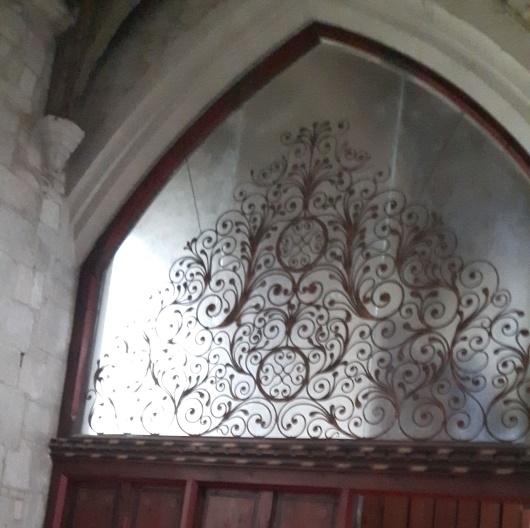
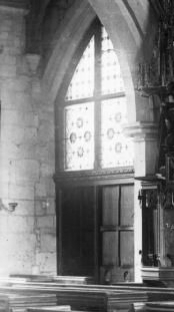
29 November 1971 - Bridget Talbot died at the age of 86 and asked for her ashes to be scattered
‘over the little stream off the grass road between Edlesborough and Ivinghoe, in view of the nine miles stretch of wood and country, and a stone put up. …. To say I saved them for the National Trust.’
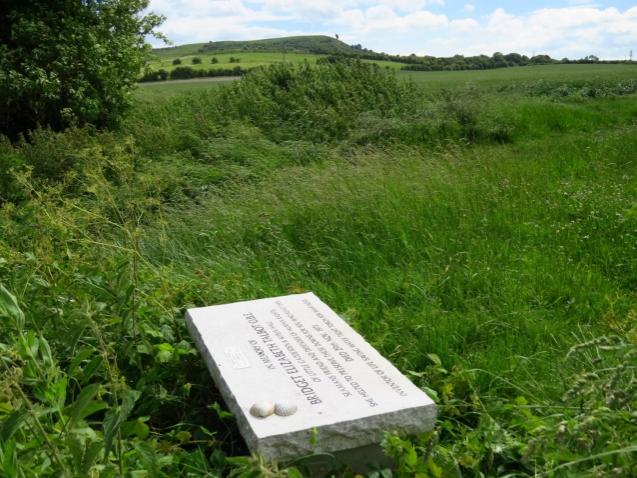
In due course a memorial bench was put up by her Trustees to mark the spot – it was renovated in 2017
If you would like to visit the spot where Bridget’s ashes were scattered walk along the bridleway from the church to the hedge you can see; her bench is just the other side, with a clear of Ivinghoe Beacon and lands she saved.
Sources of information about Bridget Talbot
- Display boards from Kiplin Hall
- ‘Little Gaddesden and Ashridge’ by Howard Senar, 1983
- Chiltern News March 2011 ‘A Beacon of Light’ by John Hockey
- A Century Remembered’ Little Gaddesden, edited by John Leonhardt
- Kiplin Hall website
- Ashridge Exhibition – National Trust
Invention of the Waterproof Torch
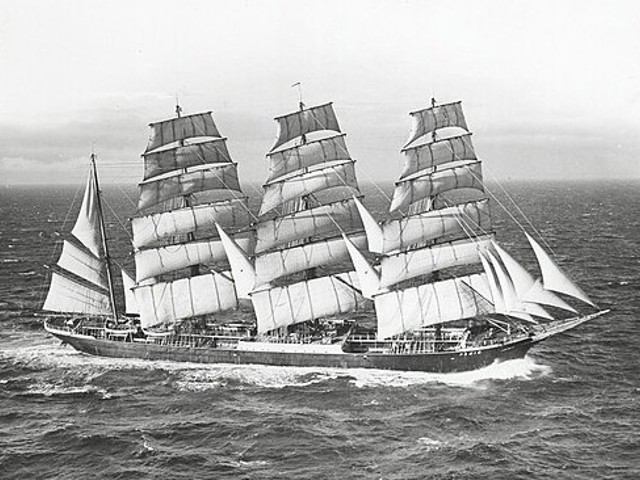
This is a photo of the Pamir, on which Bridget sailed in August 1934.
